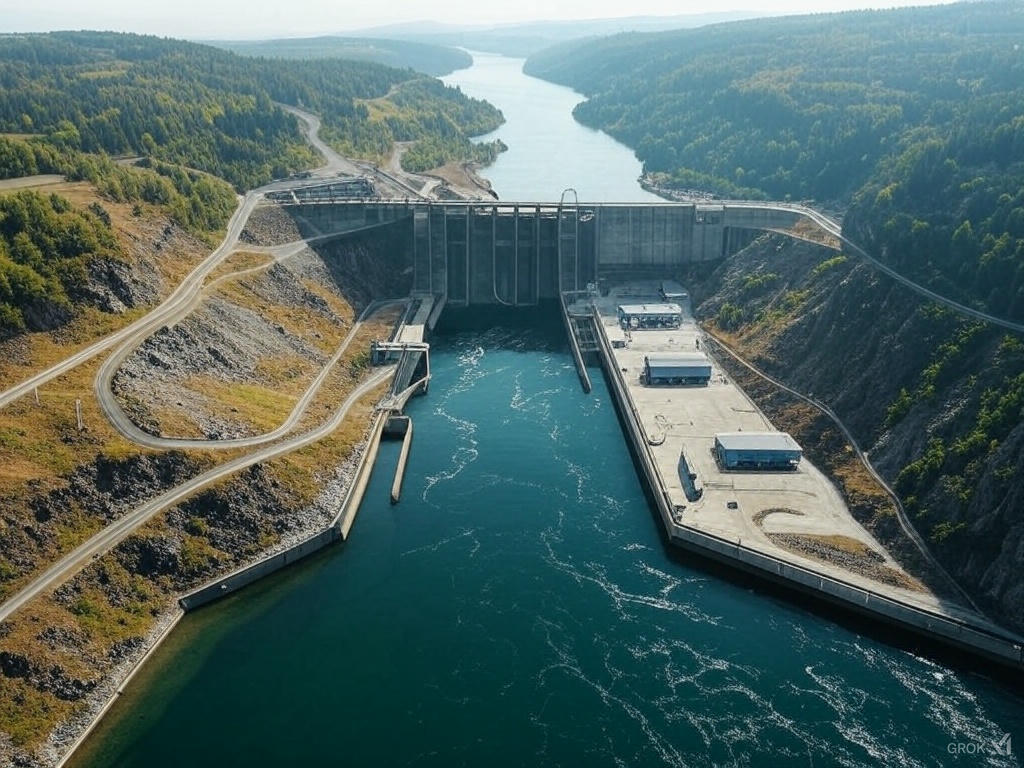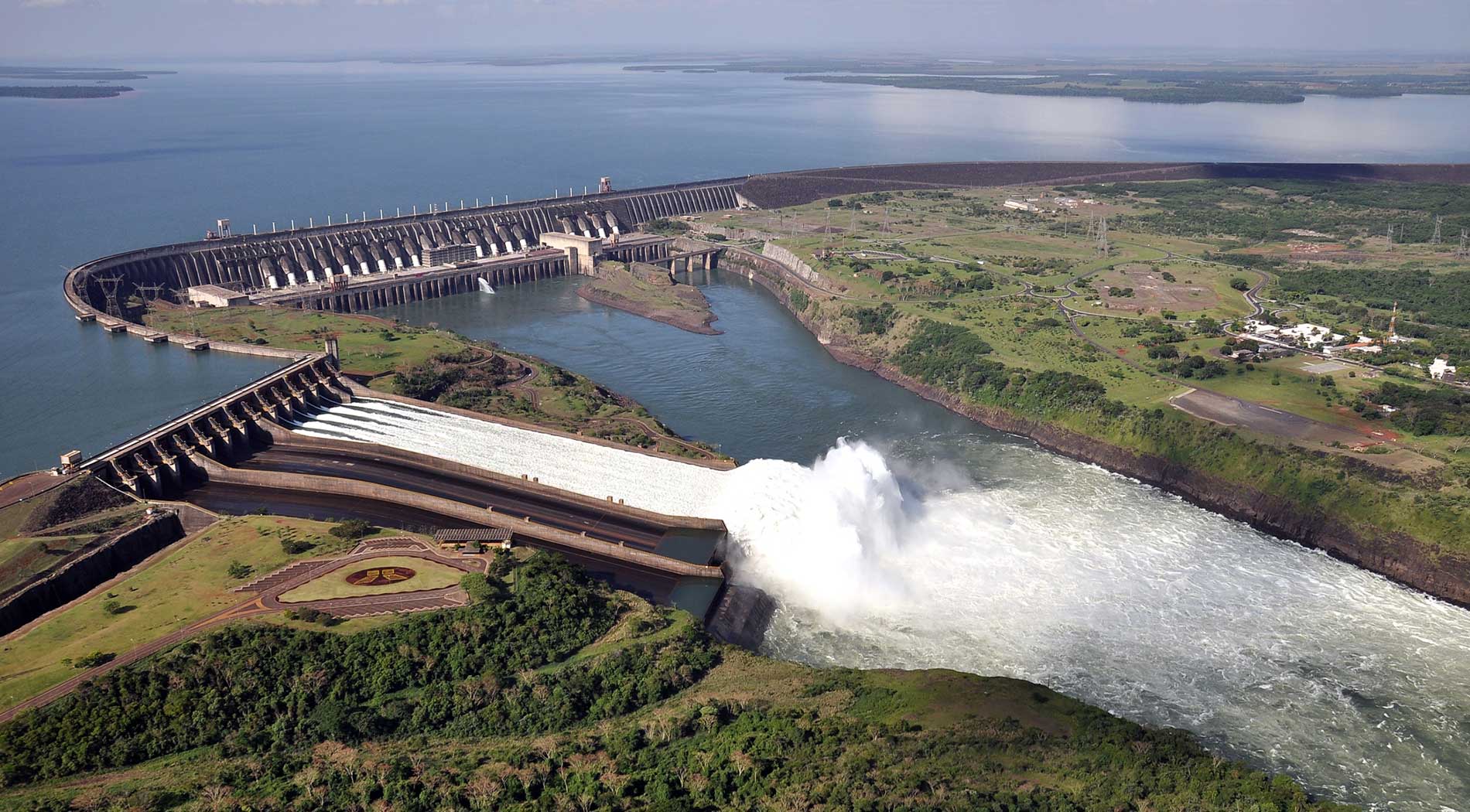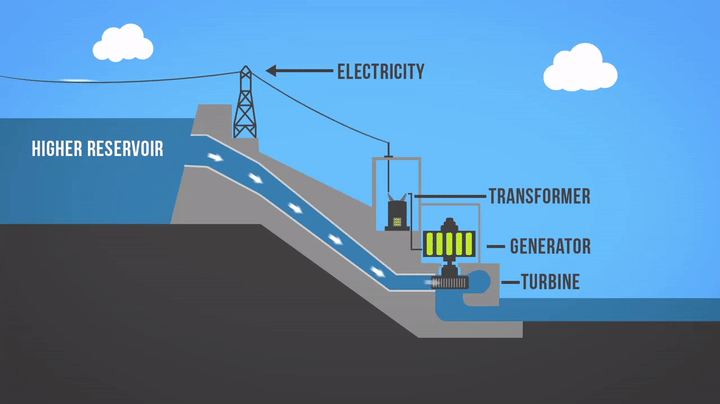the potential energy of water into kinetic energy and then into electricity. Turkey's topographic structure and hydraulic potential increase the significance of these plants in electricity generation.

Hydroelectric Power Plant (Designed with AI Assistance)
Historical Development: From Early Beginnings to the Modern Era
The origins of hydroelectric energy date back thousands of years. During the Han Dynasty in China (202 BC - 9 AD), vertical water wheels powered hammer mills were used for grinding grain and crushing minerals. The role of water power in driving economic growth has been evident since early history. In 1771, Richard Arkwright established the Cromford Mill in England, one of the world's first factory systems powered by water. Innovations in turbine technology during the 19th century marked a turning point in the development of hydroelectric energy. In 1827, French engineer Benoît Fourneyron developed the first reaction turbine, producing approximately 6 horsepower. In 1849, James Francis designed the Francis turbine, which remains the most commonly used turbine today. During the 1870s, Lester Allan Pelton invented the Pelton wheel, while in 1913, Viktor Kaplan developed the Kaplan turbine with adjustable blades.
The first hydroelectric projects emerged in the late 19th century. In 1878, a system used at the Cragside estate in England to power a single lamp is considered the first known application. In 1882, the first hydroelectric plant selling electricity to the public opened on the Fox River in Wisconsin, USA. In 1895, the Edward Dean Adams Plant at Niagara Falls became the largest hydroelectric project of its time. The 20th century witnessed rapid changes in hydroelectric technology. In the 1930s, Franklin Roosevelt's New Deal policies in the USA supported the construction of multipurpose dams like Hoover and Grand Coulee; by 1940, hydroelectric power supplied 40% of the country's electricity. Brazil and China emerged as global leaders in hydroelectric power by the late 20th century, with the Itaipu Dam (14,000 MW) opening in 1984 and the Three Gorges Dam (22,500 MW) in China ranking among the world's largest facilities.

Itaipu Dam
Basic Mechanisms: How Is Electricity Generated?
Hydroelectric power plants convert the kinetic energy of moving water into electrical energy through the following process:
- Water is released from a reservoir created by a dam in a controlled manner.
- The falling water is directed through a penstock to turbines.
- The water rotates the turbine blades, generating mechanical energy.
- The turbine shaft operates a generator, converting mechanical energy into electricity.
- The electricity is stepped up by transformers and transmitted to users via power lines.
Turbines form the core of hydroelectric power plants and are classified into two main categories:
- Impulse Turbines (e.g., Pelton): All potential energy of water is converted into kinetic energy before reaching the turbine. Effective in high-head systems.
- Reaction Turbines (e.g., Francis, Kaplan): Energy conversion continues after water enters the turbine. Used in medium- and low-head systems.

Hydroelectric Power Plant Operating Principle
Types of Hydroelectric Power Plants
Hydroelectric plants are categorized based on water usage methods:
- Reservoir (Storage) Plants: A dam stores water in a reservoir and releases it to turbines as needed. The Grand Coulee Dam (6,765 MW) in the USA is an example.
- Run-of-River Plants: Utilize the natural flow of a river without a dam. They have a lower environmental impact and are common in small-scale projects.
- Pumped Storage Plants: Pump water from a lower reservoir to an upper reservoir during low demand and release it back during high demand, acting as a massive energy storage system.
Plants are also classified by installed capacity:
- Micro (<100 kW): Suitable for single homes or villages.
- Mini (100-1,000 kW): Serves small communities.
- Small (1,000-10,000 kW): Provides regional power supply.
- Large (>10,000 kW): Supplies large-scale grid electricity.
Hydroelectric Power Plants in Turkey
The history of hydroelectric power plants in Turkey dates back to projects initiated in 1902. Public sectors, private companies, and municipalities have established numerous facilities to utilize the country’s hydraulic resources. The total installed capacity of active and ongoing HPP projects in Turkey is 2,638 MW. Notable projects include:
- Oymapınar HPP (Antalya): With a capacity of 540 MW, it generates 1,620,000,000 kWh annually. Modernization has increased its efficiency by 5%.
- Beyhan-1 HPP (Elazığ): A 582 MW facility completed in 48 months in 2015.
- Kaleköy-1 HPP: An ongoing project with a capacity of 630 MW.
Additionally, municipalities have implemented HPPs within drinking water transmission lines to generate energy without compromising water quality. Turkey has set a 1 MW cap for unlicensed electricity generation, regulated by the "Regulation on Unlicensed Electricity Generation in the Electricity Market."
Advantages and Disadvantages
Advantages
- Energy generation without fuel costs.
- Long lifespan and low maintenance costs.
- Utilization of domestic resources, reducing greenhouse gas emissions.
- Quick response capability to meet peak demands.
Disadvantages
- High construction costs and environmental impacts (habitat loss, disruption of migration routes).
- Dependence on climate change and drought conditions.
- Methane emissions from decaying vegetation in large reservoirs.
Sustainability and Future Prospects
As a renewable resource, hydroelectric power plays a crucial role in reducing carbon emissions. However, sustainability requires balancing environmental and social impacts. The World Commission on Dams' 2000 report marked a turning point in achieving this balance. In 2004, the International Hydropower Association (IHA) developed Sustainability Guidelines to assess projects throughout their lifecycle.
In the future, untapped potential in Africa and Asia could expand hydroelectric capacity. The International Energy Agency (IEA) forecasts a global capacity increase of 230 GW by 2030. In Turkey, the efficient use of hydraulic resources remains a strategic priority in meeting the growing energy demand.
Hydroelectric power plants have harnessed the power of water for thousands of years to serve humanity. With their historical development, technological innovations, and environmentally conscious modern applications, this energy source remains a cornerstone of a sustainable future. Turkey continues to take significant steps in this field, leveraging its topographic advantages. However, minimizing environmental impacts will be crucial for the long-term success of this technology.

